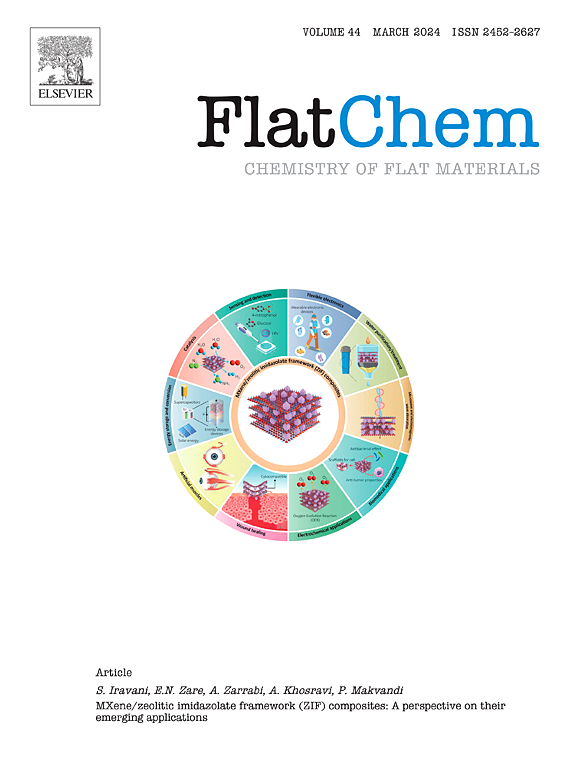无定形硼酸镍纳米片中镍的快速自重构及其在碱性海水裂解中高效析氧的研究
IF 6.2
3区 材料科学
Q2 CHEMISTRY, PHYSICAL
引用次数: 0
摘要
非晶态硼酸镍(NiB)中真(Ni2+)活性位点向Ni3+活性位点的转变在碱水/海水裂解中至关重要。在本研究中,我们通过添加铁来增强非晶NiB纳米片的析氧反应(OER)性能。掺入的铁丰富了电导率,促进了NiFeB中真正活性位点的形成。这种独特的NiFeB纳米片结构具有更多的活性位点和更大的开放表面积,从而允许更好的电解质扩散。优化后的电催化剂表现出令人印象深刻的OER活性,过电位为180 mV (50 mA cm−2),塔菲尔斜率小(63 mV dec−1),在碱性水中表现出超过24小时的优异耐久性。同样,在碱性海水中,NiFe0.5B纳米片的过电位为185 mV,达到50 mA cm−2,Tafel斜率为46 mV dec−1,并且在24 h内具有优异的耐久性。对于碱性水中的析氢反应,非晶态NiFe0.5B纳米片在10 mA cm−2时的过电位为290 mV, Tafel斜率为195 mV dec−1。在整体碱性海水分解中,催化剂在1.63 V的最低电池电压下提供50 mA cm−2,具有优异的稳定性。这项工作为非晶态过渡金属硼酸盐OER催化剂的经济高效设计提供了有价值的见解。本文章由计算机程序翻译,如有差异,请以英文原文为准。

Rapid self-reconstruction of nickel in amorphous nickel borate nanosheets for efficient oxygen evolution in alkaline seawater splitting
Enhancing the transformation of true (Ni2+ to Ni3+) active site in amorphous nickel borate (NiB) is the paramount importance in alkaline water/ seawater splitting. In this study, we strengthen the oxygen evolution reaction (OER) performance of amorphous NiB nanosheets by adding Fe. The incorporated Fe enriches conductivity which facilitating formation of real active site in the NiFeB. This unique nanosheet structure of NiFeB features more active sites and large open surface area that permit the better electrolyte diffusion. The optimized electrocatalyst demonstrates impressive OER activity with an ultra-low overpotential of 180 mV (50 mA cm−2), a small Tafel slope (63 mV dec−1) also exhibits exceptional durability over 24 h in alkaline water. Similarly, in alkaline seawater, the catalyst displays a low over potential of 185 mV to reach 50 mA cm−2, a small Tafel slope 46 mV dec−1 and excellent durability over 24 h. For the hydrogen evolution reaction in alkaline water, the amorphous NiFe0.5B nanosheet shows low overpotential as 290 mV at 10 mA cm−2, a small Tafel slope 195 mV dec−1. In overall alkaline seawater splitting, the catalyst delivers 50 mA cm−2 at the lowest cell voltage of 1.63 V with exceptional stability. This work provides valuable insights into the cost-effective design of amorphous transition metal borate OER catalyst for seawater splitting.
求助全文
通过发布文献求助,成功后即可免费获取论文全文。
去求助
来源期刊

FlatChem
Multiple-
CiteScore
8.40
自引率
6.50%
发文量
104
审稿时长
26 days
期刊介绍:
FlatChem - Chemistry of Flat Materials, a new voice in the community, publishes original and significant, cutting-edge research related to the chemistry of graphene and related 2D & layered materials. The overall aim of the journal is to combine the chemistry and applications of these materials, where the submission of communications, full papers, and concepts should contain chemistry in a materials context, which can be both experimental and/or theoretical. In addition to original research articles, FlatChem also offers reviews, minireviews, highlights and perspectives on the future of this research area with the scientific leaders in fields related to Flat Materials. Topics of interest include, but are not limited to, the following: -Design, synthesis, applications and investigation of graphene, graphene related materials and other 2D & layered materials (for example Silicene, Germanene, Phosphorene, MXenes, Boron nitride, Transition metal dichalcogenides) -Characterization of these materials using all forms of spectroscopy and microscopy techniques -Chemical modification or functionalization and dispersion of these materials, as well as interactions with other materials -Exploring the surface chemistry of these materials for applications in: Sensors or detectors in electrochemical/Lab on a Chip devices, Composite materials, Membranes, Environment technology, Catalysis for energy storage and conversion (for example fuel cells, supercapacitors, batteries, hydrogen storage), Biomedical technology (drug delivery, biosensing, bioimaging)
 求助内容:
求助内容: 应助结果提醒方式:
应助结果提醒方式:


